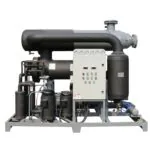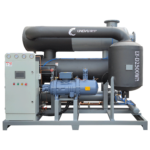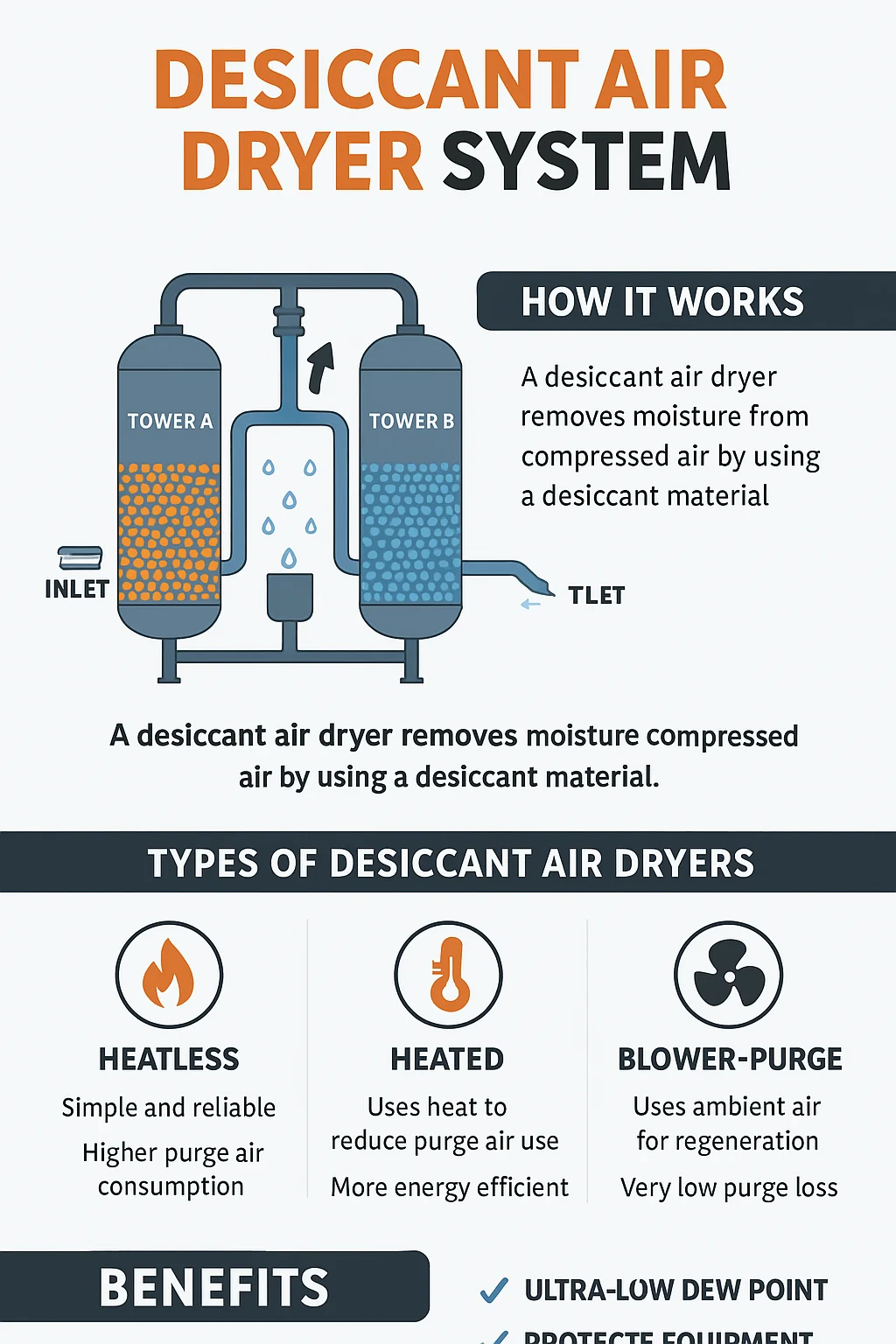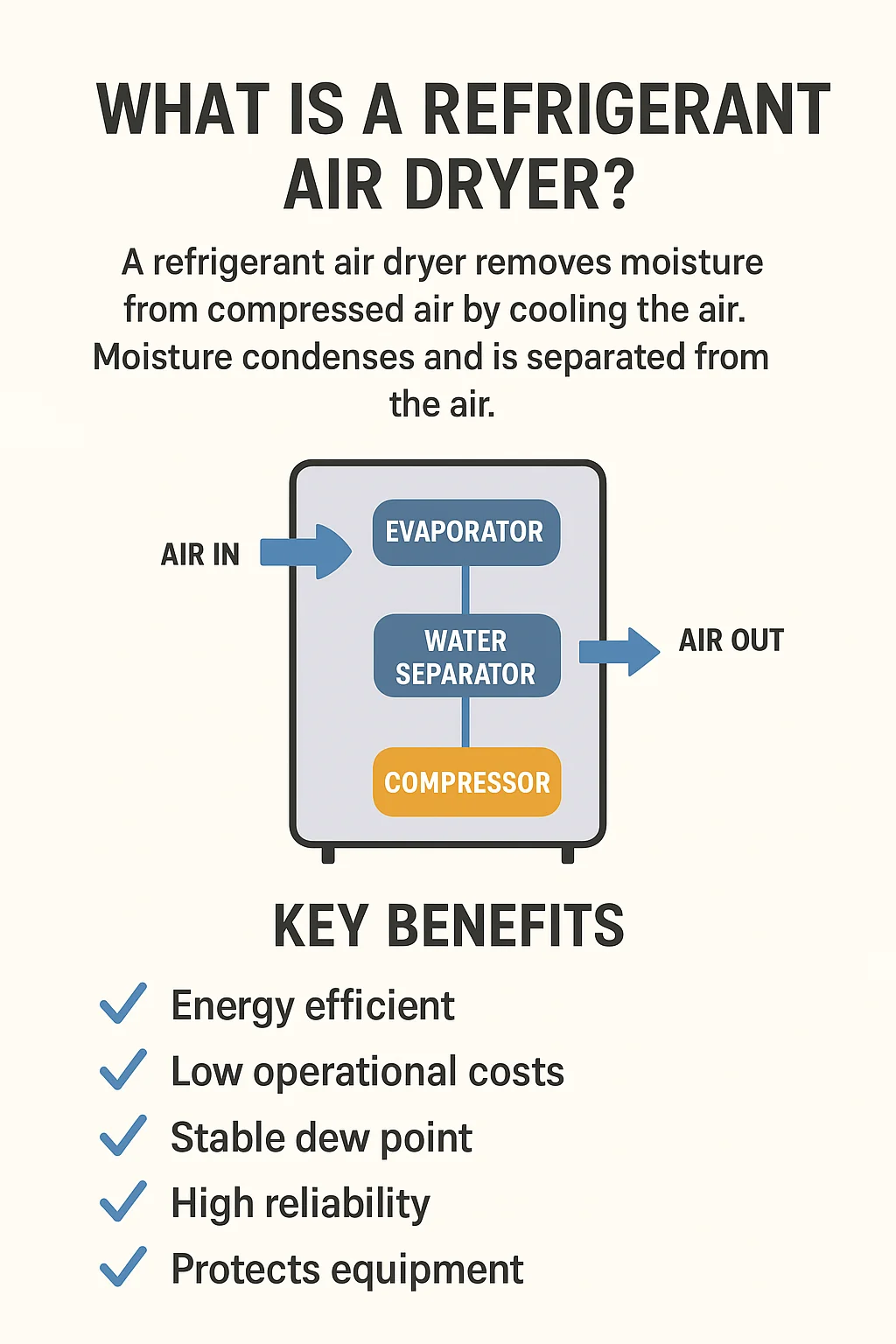Why a Refrigerated Compressed Air Dryer Is Essential
Compressed air systems are critical in manufacturing, automotive, packaging, and many other industries. However, without proper air treatment, moisture in compressed air can damage tools, corrode pipelines, and compromise product quality.
That’s why investing in a refrigerated compressed air dryer is not just smart—it’s essential.
A refrigerated compressed air dryer removes moisture by cooling the air to near-freezing temperatures, causing water vapor to condense and separate from the air stream. This ensures that only clean, dry air enters your tools and machinery—preventing rust, breakdowns, and system inefficiency.
What Is a Refrigerated Compressed Air Dryer?
A refrigerated compressed air dryer is a device that reduces the moisture content in compressed air using a refrigeration-based cooling system. As air passes through the dryer, it is cooled to approximately 35°F–50°F (1.6°C–10°C), causing water vapor to condense and be drained away.
Two Main Types:
Non-Cycling Refrigerated Dryers: Operate continuously; simple and cost-effective for steady loads.
Cycling Refrigerated Dryers: Use thermal mass or variable-speed technology to save energy during low demand.
How It Works:
Hot compressed air enters the dryer
Air is cooled via a refrigeration circuit
Water condenses and is drained out
Dry air is reheated before returning to the system
The result? Consistently dry compressed air, free of damaging moisture.
Key Features and Benefits
✅ Moisture-Free Compressed Air
Prevent corrosion, scaling, and malfunctions by eliminating water vapor from your air system.
✅ Energy-Efficient Operation
Advanced cycling models adjust energy usage to match demand, reducing power consumption.
✅ Easy to Install & Maintain
Compact footprint, plug-and-play setup, and minimal maintenance requirements.
✅ Consistent Dew Point Control
Maintains dew point around +3°C (37°F) to ensure reliability in most industrial settings.
✅ Extended Equipment Life
Keep downstream tools, valves, actuators, and piping in top condition by eliminating water-related damage.
Technical Specifications Example
| Parameter | Value |
|---|---|
| Flow Rate | 20 – 2000+ SCFM (customizable) |
| Dew Point | 35°F to 50°F |
| Power Supply | 110V/220V/380V options |
| Max Inlet Temperature | 120°F (standard models) |
| Max Operating Pressure | 150 psi (10 bar) |
| Refrigerant Type | R134a / R407C |
| Drain Type | Automatic electronic drain |
| Control Panel | LED or digital display with alarms |
🧊 Protect Your System with a High-Performance Refrigerated Compressed Air Dryer
Tired of moisture-related issues in your compressed air system? Upgrade your setup with our industry-proven refrigerated compressed air dryers.
✅ Available in multiple flow capacities
✅ Low-pressure drops and consistent dew points
✅ Smart controls for efficient energy usage
✅ CE and ISO certified, suitable for global markets
💡 Don’t let water vapor damage your tools or slow production. Our dryers deliver clean, dry air—day after day.
Applications of Refrigerated Compressed Air Dryers
These dryers are widely used in:
🏭 Manufacturing Plants – Machine tools, injection molding, automation
🛠 Automotive Workshops – Spray painting, pneumatic tools, tire inflation
🥫 Food and Beverage – Packaging, bottling lines, conveying systems
💊 Pharmaceutical Facilities – Capsule filling, cleanroom air
📦 Packaging Industry – Air knives, vacuum sealing, labeling
🏗 Construction – Pneumatic drills, sandblasting, jackhammers
Whether you run a small shop or a large industrial line, a refrigerated compressed air dryer keeps your system dry and dependable.
How to Choose the Right Refrigerated Compressed Air Dryer
✅ Step 1: Calculate Flow Requirements
Know your compressor output in SCFM or m³/min.
✅ Step 2: Check Inlet Conditions
Evaluate inlet temperature and humidity levels to choose the right model.
✅ Step 3: Consider Energy Efficiency
Cycling models cost more upfront but save power long-term.
✅ Step 4: Plan for Maintenance
Ensure drain access, filter change space, and airflow around the unit.
✅ Step 5: Budget vs. Performance
Find a balance between initial investment and long-term savings.
Maintenance Tips
🔧 Inspect and clean condenser coils monthly
🔧 Check and test the automatic drain valve weekly
🔧 Replace pre-filters regularly
🔧 Verify dew point readings
🔧 Schedule annual refrigerant inspections
Routine maintenance ensures your refrigerated compressed air dryer remains energy-efficient and reliable.
FAQ – Refrigerated Compressed Air Dryer
How does a refrigerated compressed air dryer work?
It cools the air to 35°F–50°F to condense and remove moisture, delivering dry air to your system.
What’s the difference between cycling and non-cycling models?
Cycling dryers adjust refrigeration output to demand, reducing energy use. Non-cycling run continuously at full power.
What is the typical dew point?
Most models maintain dew points around +3°C (37°F)—ideal for general industrial applications.
Can I install this dryer outdoors?
Most models are indoor rated, but weatherproof versions are available.
Is pre-filtration necessary?
Yes, using a pre-filter helps remove oil and particles, extending the dryer’s life and performance.
Conclusion: Invest in Reliable Air Quality with a Refrigerated Compressed Air Dryer
A refrigerated compressed air dryer is a crucial piece of any compressed air system. Whether you’re protecting sensitive machinery or ensuring top product quality, these dryers provide a cost-effective, energy-efficient, and reliable way to remove moisture.
Don’t leave your production line vulnerable to water vapor. Choose a refrigerated compressed air dryer designed to perform under pressure—literally.
Related products:

The 3885 CFM refrigerated air dryer (water cooled) is a high-capacity industrial solution designed for removing moisture from large-scale compressed air systems. Built for continuous and demanding operation, this water-cooled unit ensures a steady dew point and maximum system protection. Whether you're operating in petrochemical, steel, manufacturing, or pharmaceutical industries, the 3885 CFM refrigerated air dryer delivers superior drying performance and energy efficiency.

The 4238 CFM refrigerated air dryer (water cooled) is a high-capacity, industrial-grade dryer designed to eliminate moisture from large compressed air systems. Built with a powerful water-cooled refrigeration circuit, this dryer ensures reliable and continuous moisture removal with a stable pressure dew point. For industries that demand high airflow rates and dependable air quality, the 4238 CFM refrigerated air dryer (water cooled) is the ideal solution.

The 8830 CFM refrigerated air dryer (water cooled) is a top-tier industrial solution engineered to remove moisture from large-scale compressed air systems. Built for ultra-high capacity applications, this dryer ensures consistently dry air with a stable dew point and superior thermal control using an advanced water-cooled condenser system.







